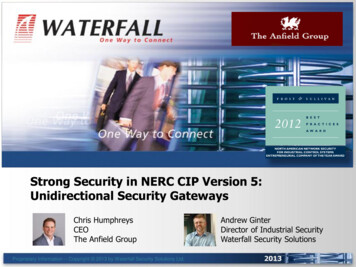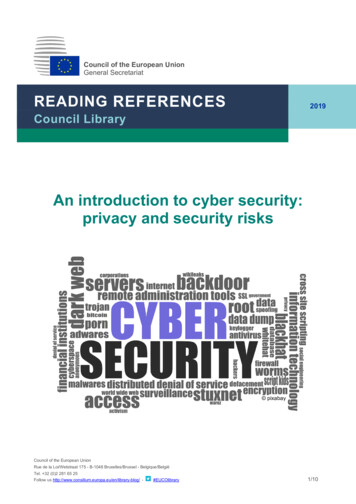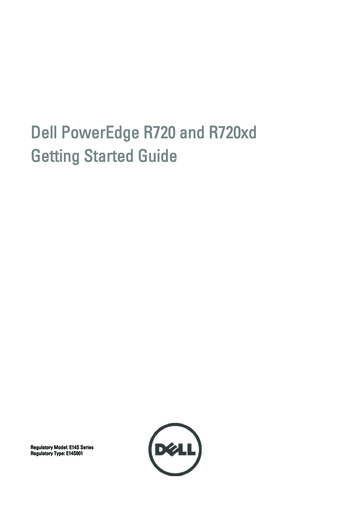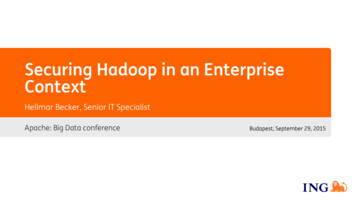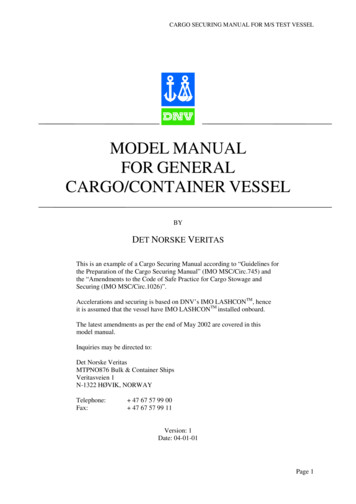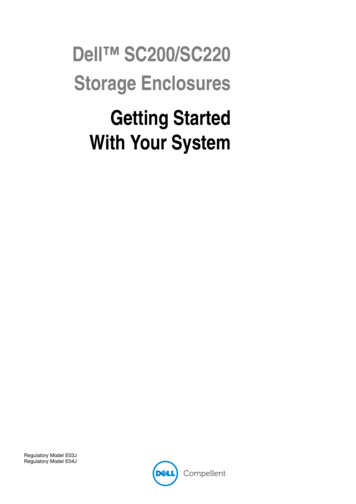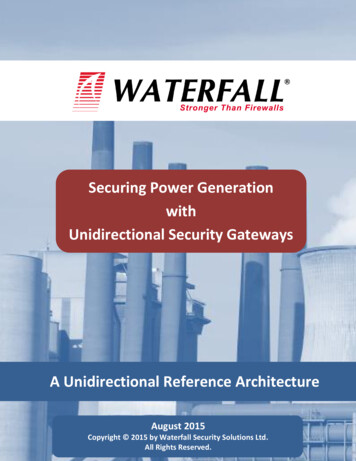
Transcription
Proprietary Information – Copyright 2015 by Waterfall Security Solutions Ltd.Securing Power GenerationwithUnidirectional Security GatewaysA Unidirectional Reference ArchitectureAugust 2015Copyright 2015 by Waterfall Security Solutions Ltd.All Rights Reserved.
Proprietary Information – Copyright 2015 by Waterfall Security Solutions Ltd.2 / 21- Legal Notice & Disclaimer Any and all third party intangible and/or proprietary and/or intellectual property rights ("ThirdParties’ Rights"), mentioned herein, whether registered or not, including, without limitation,patents, trademarks, service marks, trade names, copyrights and computer applications, belong totheir respective owners. Waterfall Security Solutions Ltd. disclaims any and all interest in all suchThird Parties’ Rights. It is forbidden to copy, modify, amend, delete, augment, publish, transmit,create derivative works of, create or sell products derived from, display or post, or in any otherway exploit or use such Third Parties’ Rights without the express authorization of their respectiveowners.Except as specified herein, Waterfall Security Solutions Ltd. does not guarantee nor make anyrepresentations with regard to any and all third party tangible and/or intangible and/or proprietaryand/or intellectual property ("Third Party Property") mentioned herein. WaterfallSecurity Solutions Ltd. does not endorse nor makes warranties as to the completeness, accuracy orreliability of such Third Party Property, and all such warranties are hereby expressly and strictlydisclaimed.Waterfall Security Solutions Ltd.21 Hamelacha St. Afek Industrial Park,Rosh Ha’ayin, 48091 IsraelOffice: 972-3-9003700 ; Fax: 972-3-9003707North America Offices,Waterfall Security Solutions USA.1133 Broadway, Suite 708, New York, NY, 10010Office: (212) 714-6058 ; Fax: (212) 465-3497www.waterfall-security.com
Proprietary Information – Copyright 2015 by Waterfall Security Solutions Ltd.3 / 21- Table of Contents –EXECUTIVE SUMMARY . 4MODERN THREATS . 5IT-CENTRIC SECURITY NOT ENOUGH FOR POWER PLANTS . 6MODERN PROTECTIONS: UNIDIRECTIONAL GATEWAYS . 7USE CASE: SAFE IT/OT INTEGRATION . 8HISTORIAN AND DATABASE REPLICATION . 8OPTIONAL: SECURITY UPDATES . 8OPTIONAL: SIEM AND OTHER IT INTEGRATIONS . 8SECURITY BENEFITS . 9USE CASE: VENDOR REMOTE MONITORING . 10VENDOR MONITORING . 10OPTIONAL: REMOTE ADJUSTMENT . 10SECURITY BENEFITS . 10USE CASE: CONTROL CENTER COMMUNICATIONS . 12SECURE CONTROL OF PEAKING PLANTS . 12SECURITY BENEFITS . 12USE CASE: PROTECTING RELAY AND SAFETY NETWORKS . 13SECURE MONITORING OF SAFETY AND PROTECTION SYSTEMS . 13SECURITY BENEFITS . 13NERC CIP COMPLIANCE BENEFITS. 14EXEMPTIONS FROM 30% OF NERC CIP V5 REQUIREMENTS . 14NERC CIP V6 . 15COST SAVINGS . 16IT/OT COST SAVINGS . 16OTHER COST SAVINGS. 16THE COST OF RISK . 17UNIDIRECTIONAL REFERENCE ARCHITECTURE . 18WHICH OF OUR CONTROL SYSTEMS IS EXPENDABLE? . 20ABOUT WATERFALL SECURITY SOLUTIONS. 21Waterfall Security Solutions Ltd.21 Hamelacha St. Afek Industrial Park,Rosh Ha’ayin, 48091 IsraelOffice: 972-3-9003700 ; Fax: 972-3-9003707North America Offices,Waterfall Security Solutions USA.1133 Broadway, Suite 708, New York, NY, 10010Office: (212) 714-6058 ; Fax: (212) 465-3497www.waterfall-security.com
Proprietary Information – Copyright 2015 by Waterfall Security Solutions Ltd.4 / 21Executive SummaryCyber threats become more sophisticated over time, and so our defenses must continue toevolve as well. Traditional IT-style defensive architectures depend unduly on firewalls andintrusion detection systems. Firewalls allow attacks to pass from untrusted to trustednetworks. Intrusion detection systems detect some attacks, and miss others. In most casesdetecting, investigating and remediating intrusions takes so long that intrusion detectionsystems are not effective at preventing attackers from achieving their cyber-espionage,cyber-sabotage or equipment-damaging goals. This is unacceptable.This paper describes a modernreference architecture for defense-indepth network protection of powerplants, illustrated in Figure (1). Thearchitecture recognizes that everycomputer, device or machineexchanging messages with theInternet is potentially compromisedand therefore untrustworthy, and thatevery machine exchanging messageswith an untrustworthy machine issimilarly untrustworthy. In theFigure then, only the green and blueplant networks are trustworthy.Figure (1) Modern Unidirectional Reference ArchitectureThese networks are protected byUnidirectional Gateway technologies, whose stronger-than-firewalls protections eliminatethe threat of network attacks from untrusted networks, and eliminate external networkconnectivity cyber risks to protected, reliability-critical networks.This architecture supports all business needs and modern communications requirementsfor electric generation sites including: Safe IT/OT integrationICS & turbine vendor remote monitoringControl center communicationsProtecting relay and safety networksReduced NERC CIP V5 and V6 compliance costsGiven that unidirectional, stronger-than-firewall protections and architectures exist and arein widespread use, we all must begin asking: “which of our turbines, generators and indeedentire power plants are expendable enough to protect with firewalls and software alone?”The answer is self-evident. The time to act is now; the threat grows by the day.Waterfall Security Solutions Ltd.21 Hamelacha St. Afek Industrial Park,Rosh Ha’ayin, 48091 IsraelOffice: 972-3-9003700 ; Fax: 972-3-9003707North America Offices,Waterfall Security Solutions USA.1133 Broadway, Suite 708, New York, NY, 10010Office: (212) 714-6058 ; Fax: (212) 465-3497www.waterfall-security.com
Proprietary Information – Copyright 2015 by Waterfall Security Solutions Ltd.5 / 21Modern ThreatsThe electric grid has been identified as a strategic target for nation-state, terrorist, hacktivistand other attacks, and power plants are essential elements of the electric grid. Targeted“ransomware” attacks can encrypt control system components, triggering shutdowns longenough to tempt a utility to pay the attacker’s multi-million dollar demands. Hacktivistsseeking to embarrass utilities or punish them for some imagined slight need only damagea handful of control system computers to trigger multi-day outages. More-sophisticatedattacks on protective relays and safety instrumented systems risk consequences such asequipment damage, injuries andenvironmental damage.Modern Attacks:Textbook, modern, network attacks Penetrate firewalls by spear-phishing,begin with a piece of malware gaining Evade anti-virus systems with custommalware deployed in volumes too low toa foothold on corporate networks,trigger AV signature creation,established by deceiving a power Use professionals to operate sophisticatedutility’s employee into downloadingmalware by interactive remote control,and running an attachment. The Gather passwords and password hashes,attachment is generally custom-written, Create accounts on domain controllers andso that no anti-virus, intrusionremote access systems, and thenprevention, or intrusion detection Log in to those accounts like any other user.signatures identify the attachment asmalware. The malware typicallytunnels a remote control connection to a command and control server on the Internet, byhiding its communications within a web application protocol the corporate firewall thinksit understands, and therefore allows. The attacker uses the remote control connection tocompromise select additional machines, on the same network or deeper in the networkarchitecture through layers of firewalls. In this way, the attackers are able to reach andinteract with even those machines and networks that are configured to be unable to interactwith the Internet. Once deep enough into their target, these attackers ultimately launch theirend-game attack: either stealing information, shutting down control systems and entireplants, or even damaging rotating equipment.These modern attacks routinely defeat all software protections, including firewalls,encryption, intrusion detection systems, anti-virus systems, security update programs, andstrong password management systems.Waterfall Security Solutions Ltd.21 Hamelacha St. Afek Industrial Park,Rosh Ha’ayin, 48091 IsraelOffice: 972-3-9003700 ; Fax: 972-3-9003707North America Offices,Waterfall Security Solutions USA.1133 Broadway, Suite 708, New York, NY, 10010Office: (212) 714-6058 ; Fax: (212) 465-3497www.waterfall-security.com
Proprietary Information – Copyright 2015 by Waterfall Security Solutions Ltd.6 / 21IT-Centric Security Not Enough for Power PlantsFor years, IT-centric security has been held up as the “gold standard” for control systemnetworks. This understanding is changing. Increasingly, experts recognize that IT-centricsecurity fails to meet the needs of control system networks.Traditional control-system defense-in-depth advice recommends firewalls, encryption,anti-virus systems, security updates and many other host and network hardening measures.A traditional, firewall-based network architecture is illustrated in Figure (2).TraditionalIT-centricadvicerecognizes that firewalls are porousby design; they forward messagesfrom untrusted to trusted networks.IT-centric advice further recognizesthat all software-based securitymechanisms have vulnerabilities. Allof this is why the pinnacle oftraditional defense-in-depth advice isalways Intrusion Detection Systems(IDSs) staffed by security experts, ineffect “pitting our experts againsttheirs.” IT-centric advice encouragesa determination to actively seek outcompromised machines, containthem, identify stolen data, and restorethe affected machines from backups.Figure (2): Traditional firewall-centricnetwork architectureAn expert consensus is emerging which regards this traditional IT-centric advice asinsufficient to address the threat of modern, cyber-sabotage attacks on power plants. Theessential difference between IT systems and control systems is, not surprisingly, control.Control systems operate large, complex, dangerous physical processes. Damaged turbinesand transformers cannot be “restored from backup.” Worse, intrusion detection, responseand remediation take time: months for the average compromise. For all of this time, aremote attacker has control of our critical control and protection systems.Modern advice for control systems recognizes that, while intrusion detection has a place ina defensive architecture, the foundation of the architecture must be intrusion prevention.Any malicious operation of plant equipment, however briefly, poses an unacceptable risk.Waterfall Security Solutions Ltd.21 Hamelacha St. Afek Industrial Park,Rosh Ha’ayin, 48091 IsraelOffice: 972-3-9003700 ; Fax: 972-3-9003707North America Offices,Waterfall Security Solutions USA.1133 Broadway, Suite 708, New York, NY, 10010Office: (212) 714-6058 ; Fax: (212) 465-3497www.waterfall-security.com
Proprietary Information – Copyright 2015 by Waterfall Security Solutions Ltd.7 / 21Modern Protections: Unidirectional GatewaysAdvice for the protection of control system networks is being updated to reflect thestronger-than-firewall protections afforded by a family of technologies based on andcomplementing Unidirectional Security curity GatewayUnidirectional Security Gateways are used when data flows out ofa critical network routinely, and when updates are required backinto that network only rarely. Unidirectional Gateways permit datato flow out of critical networks into less-trusted networks, butphysically prevent any attack, any message and any signalwhatsoever from passing back into reliability-critical networks.Waterfall FLIPThe Waterfall FLIP is used when data flows out of a criticalnetwork routinely, and when updates must flow back into thatnetwork frequently and periodically. The FLIP is a UnidirectionalSecurity Gateway whose orientation can periodically reverse. TheFLIP hardware makes remote-control persistent targeted attacksphysically d Unidirectional Gateways are used whencontinuous data flows are necessary both out of and into criticalnetworks. Two completely independent Unidirectional Gatewaysystems are deployed to support the continuous data flows.Application DataControlApplication Data Control is a software add-on to all of the aboveproducts providing policy-based controls over industrial dataflows, even for encrypted, compressed, proprietary andundocumented industrial protocols. This represents an extra layerof fine-grained control, in addition to the hardware-basedunidirectional protections.Secure BypassSecure Bypass is an electromechanical switch, able to electricallyconnect and disconnect two copper network cables. The defaultmode for the switch is the disconnected state. In reliabilityemergencies, the switch can be manually activated to permitconventional interactive remote access for the duration of thedeclared emergency.Table (1) Unidirectional Security Gateway TechnologiesWaterfall Security Solutions’ family of Unidirectional Security Gateway products allprovide stronger-than-firewall protections for control system networks, and are designedspecifically to defeat modern, professional-grade, targeted attacks.Waterfall Security Solutions Ltd.21 Hamelacha St. Afek Industrial Park,Rosh Ha’ayin, 48091 IsraelOffice: 972-3-9003700 ; Fax: 972-3-9003707North America Offices,Waterfall Security Solutions USA.1133 Broadway, Suite 708, New York, NY, 10010Office: (212) 714-6058 ; Fax: (212) 465-3497www.waterfall-security.com
Proprietary Information – Copyright 2015 by Waterfall Security Solutions Ltd.8 / 21Use Case: Safe IT/OT IntegrationThe most common use of Unidirectional Security Gateways in power plants is to enablesafe IT/OT integration. The gateways generally replace unacceptably-vulnerable1 firewallbased integrations of networks and applications.Historian and Database ReplicationThe most common unidirectionalIT/OT integration architecture is aUnidirectional Security Gatewayintegrating plant IT and OTnetworks via a historian database, orrelational database. When there is ahistorian or other database on theplantnetwork, the gatewayreplicates the plant database to thecorporate network, where corporateFigure (3) Safe IT/OT Integrationusers and applications can query thereplica without any threat to the control system network. When there is only an enterprisedatabase, the gateways replicate Modbus, OPC and other servers and devices to thecorporate network, so that the corporate historian or other database applications can acquiredata from the control system data source replicas.Optional: Security UpdatesWhen regular anti-virus updates, WSUS or other security updates must be sent into theplant network, a Waterfall FLIP can be substituted for the Unidirectional Security Gateway.The FLIP provides for a disciplined flow of such updates into plant networks, without everintroducing the vulnerabilities that always accompany firewall deployments.Optional: SIEM and Other IT IntegrationsWaterfall’s Unidirectional Gateway-based products are often configured to replicate avariety of IT-centric data sources from plant networks to corporate networks as well. Fileservers can be replicated, to simplify reporting, debugging and other file transfers fromplant networks to corporate and so minimize the use of removable media. Syslog serversand SNMP data sources can be replicated to Security Information and Event Management(SIEM) systems in corporate SOCs and NOCs. When branch SIEMs have been deployedon control system networks, Unidirectional Gateway products are able to replicate thosebranch SIEMs as well, aggregating plant information into an enterprise SIEM.1See IT/OT Integration Done Right and Done Wrong, UTC Journal, 2nd Quarter 2014, athttp://www.bluetoad.com/publication/?i 218589&p 19 for a detailed example.Waterfall Security Solutions Ltd.21 Hamelacha St. Afek Industrial Park,Rosh Ha’ayin, 48091 IsraelOffice: 972-3-9003700 ; Fax: 972-3-9003707North America Offices,Waterfall Security Solutions USA.1133 Broadway, Suite 708, New York, NY, 10010Office: (212) 714-6058 ; Fax: (212) 465-3497www.waterfall-security.com
Proprietary Information – Copyright 2015 by Waterfall Security Solutions Ltd.9 / 21When additional protections are required to prevent data exfiltration, or to prevent malwarefrom moving from plant networks to the corporate network, the Application Data Controloption can be applied to the Unidirectional Security Gateway or Waterfall FLIPdeployment.Waterfall Security Solutions provides a wide array of both industrial and IT-centricreplications in order to make Unidirectional Gateway deployments a seamless replacementfor IT/OT firewalls.Security BenefitsIn all these examples, a layer of physical security in the form of the Unidirectional SecurityGateway hardware is introduced between the high-risk corporate network and reliabilitycritical control system networks, breaking the online path of attack for attacks originatingon the Internet or on other external networks. No fuzzing attack, no targeted remote controlattack, and no virus or botnet however sophisticated can penetrate the physical protectionprovided by Unidirectional Security Gateways.A related security benefit of this architecture is that with Unidirectional Security Gatewaytechnology in place, there is no possibility that reliability-critical systems can depend onpotentially-compromised IT systems, such as corporate Active Directory servers, DNSservers, documentation web servers, file servers and many other single points ofcompromise on untrusted corporate networks. Safe IT/OT integration via UnidirectionalSecurity Gateways renders such unsafe dependencies impossible.Waterfall Security Solutions Ltd.21 Hamelacha St. Afek Industrial Park,Rosh Ha’ayin, 48091 IsraelOffice: 972-3-9003700 ; Fax: 972-3-9003707North America Offices,Waterfall Security Solutions USA.1133 Broadway, Suite 708, New York, NY, 10010Office: (212) 714-6058 ; Fax: (212) 465-3497www.waterfall-security.com
Proprietary Information – Copyright 2015 by Waterfall Security Solutions Ltd.10 / 21Use Case: Vendor Remote MonitoringAt most power plants, there is a need to support control system vendor “monitoring anddiagnostics” programs. This is especially true for turbine vendors, since such vendorsgenerally honor hardware warrantees and support agreements only when the vendors havecontinuous access to vibration, heat distribution and other detailed data about theperformance of rotating equipment. Turbine and other ICS vendors generally also requireoccasional opportunities to adjust control-system components to address problems as theydevelop, and so prevent serious failures later on.Vendor MonitoringGenerating sites address this need by deploying aUnidirectional Gateway to replicate control-systemservers from a reliability-critical network to a vendorDMZ. The DMZ is connected by the vendor to thevendor’s central management system, most often viaa VPN across the Internet. The replicas are faithfulcopies of plant systems and provide the vendor fullvisibility into the status and condition of generatingplant systems.Optional: Remote AdjustmentIf the vendor needs to adjust control system or turbineFigure (4) ICS VendorMonitoring and Diagnosticsparameters from time to time, the vendor schedulestime with site personnel. At the appointed time, sitepersonnel sit down in front of a workstation with Waterfall’s Remote Screen View clientinstalled, enable screen mirroring through a Unidirectional Security Gateway, and call thevendor. The vendor is able to view the screen of the plant workstation via a video feedstreamed through the Unidirectional Gateway, without any ability to send any command orquery into the workstation. The vendor is able to verbally guide site personnel through aprocess of adjusting the control system and verify that corrections have been made to thevendor’s satisfaction.A secondary benefit of this approach to remote adjustment is that plant personnel are ableto supervise the adjustment process. Plant records of such adjustments can bring value toany disputes with vendors over the management of generating plant assets.Security BenefitsVendor monitoring was traditionally enabled with firewalls and VPN connections. TheVPN connections deployed between central vendor monitoring sites and generating unitsare encrypted, but encryption provides no protection from compromised vendor networks.Even connections claiming to be “monitor only” almost always enable the vendor softwareWaterfall Security Solutions Ltd.21 Hamelacha St. Afek Industrial Park,Rosh Ha’ayin, 48091 IsraelOffice: 972-3-9003700 ; Fax: 972-3-9003707North America Offices,Waterfall Security Solutions USA.1133 Broadway, Suite 708, New York, NY, 10010Office: (212) 714-6058 ; Fax: (212) 465-3497www.waterfall-security.com
Proprietary Information – Copyright 2015 by Waterfall Security Solutions Ltd.11 / 21to query control system equipment for data, and are always over a bi-directionalcommunications channel. A compromised vendor monitoring system can be used to pivotan attack across bi-directional “monitor only” links with buffer over flows and othermalicious messages sent instead of legitimate queries.Attacks work the other way as well - the central vendor site is itself at risk of attack fromall control system networks to which the vendor’s site is connected via VPNs. Vendorsmake such connections in both the friendliest and un-friendliest of geographies, and to boththe best-secured and the worst-secured control systems in their geographies.With Unidirectional Security Gateways in place, electric generators are protectedabsolutely from compromised vendor machines and networks. The vendors can monitorthe turbines continuously, but no network attack can reach back from the vendor’s centralsite into the power plant’s control system.Waterfall Security Solutions Ltd.21 Hamelacha St. Afek Industrial Park,Rosh Ha’ayin, 48091 IsraelOffice: 972-3-9003700 ; Fax: 972-3-9003707North America Offices,Waterfall Security Solutions USA.1133 Broadway, Suite 708, New York, NY, 10010Office: (212) 714-6058 ; Fax: (212) 465-3497www.waterfall-security.com
Proprietary Information – Copyright 2015 by Waterfall Security Solutions Ltd.12 / 21Use Case: Control Center CommunicationsBase-load plants frequently need to communicate with regional authorities such as thepower utility’s generation-dispatch control center. The protocol of choice is often ICCP,but may also be any of DNP3, IEC 60870-5-104, or 61850 MMS. For some base-loadplants, this communications is purely a reporting function; change orders from the regionalauthority are infrequent and are accomplished through schedules agreed to long in advance.Base load plants can be secured by outbound-oriented Unidirectional Security Gateways,as described in the IT/OT use case above.Secure Control of Peaking PlantsPeaking plants are more complex. Peaking plants require continuous reporting to ageneration dispatch center, and require a continuous, second-by-second stream of newsetpoints from the dispatch center.Unidirectional Security Gateways replicating thepower plant’s ICCP slave or other protocol slavedevices to a generating dispatch center meet the needsof some base load plants, and inbound/outboundUnidirectional Gateways can be deployed to meet theneeds of all remaining plants. The outbound Unidirectional Gateway replicates the plant’s ICCP server tothe corporate network or to a dedicated DMZ, so thatthe dispatch center’s EMS/SCADA master can poll theplant replica. The inbound Unidirectional Gatewayreplicates the EMS ICCP server back into the plantwhere plant systems query the replica for new setpoints.Figure (5) Control CenterCommunicationsSecurity BenefitsAll control centers and generating dispatch centers areattractive targets for cyber-sabotage attacks. A compromised control center is able to misoperate the grid, cause outages, and possibly cause cascading outages. A compromisedcontrol center can also be used as a platform to “pivot” attacks into partner utilities.Unidirectional Security Gateways provide absolute protection from external attacks forplants that do not require continuous commands from a control center, andinbound/outbound gateway configurations are much stronger than firewalls 1 for all otherplants. For inbound/outbound configurations, the Waterfall’s Application Data Controloption can be deployed for additional security, to permit only reasonable setpoint values toenter the plant control system from generation-dispatch control centers.1Rashiduzzaman Bulbul, Pingal Sapkota, Chee-Wooi Ten, Lingfeng Wang, and Andrew Ginter, "IntrusionEvaluation of Communication Network Architectures for Power Substations," IEEE Transactions on PowerDelivery, June 2015.Waterfall Security Solutions Ltd.21 Hamelacha St. Afek Industrial Park,Rosh Ha’ayin, 48091 IsraelOffice: 972-3-9003700 ; Fax: 972-3-9003707North America Offices,Waterfall Security Solutions USA.1133 Broadway, Suite 708, New York, NY, 10010Office: (212) 714-6058 ; Fax: (212) 465-3497www.waterfall-security.com
Proprietary Information – Copyright 2015 by Waterfall Security Solutions Ltd.13 / 21Use Case: Protecting Relay and Safety NetworksSafety equipment and protective relays are software components that are essential tomodern reliability and safety programs. These components become ineffective whencompromised, and so protecting these components is vital.Secure Monitoring of Safety and Protection SystemsUnidirectionalSecurityGateways are routinely deployedto replicate devices fromprotection and safety networks tocontrol networks for continuousmonitoring. These replicationsuse DNP3, IEC 60870, IEC61850, Modbus and otherFigure (6) Protecting Safety and Protection Networksprotocol connectors. SNMP trapsand syslog data sources may also be replicated to central Network and Security OperationsCenters for additional reliability or security monitoring. Continuous monitoring is essentialto all of security programs, process and employee safety programs, and electric systemreliability programs.These Unidirectional Gateway deployments may be the only unidirectional protections forthe safety systems, or the gateways may be deployed as a second layer of security. In thelatter case, the gateways protect safety systems from attack by plant insiders, and fromattack by malware that may have reached reliability-critical control system networks viaUSB Flash sticks and other removable media.Security BenefitsUnidirectional Gateways prevent all remote adversaries, no matter how sophisticated, fromreaching through intermediate networks into protection and safety networks. With a plant’sprotection and safety equipment safe from such attacks, utilities can be confident th
Reduced NERC CIP V5 and V6 compliance costs Given that unidirectional, stronger-than-firewall protections and architectures exist and are in widespread use, we all must begin asking: "which of our turbines, generators and indeed entire power plants are expendable enough to protect with firewalls and software alone?"
